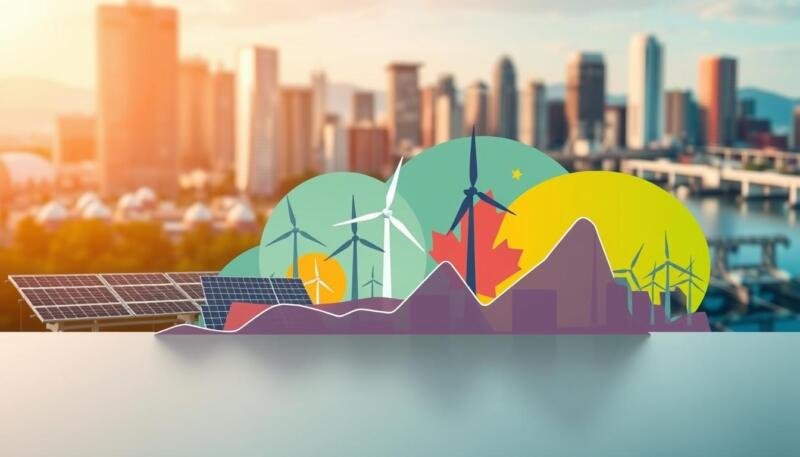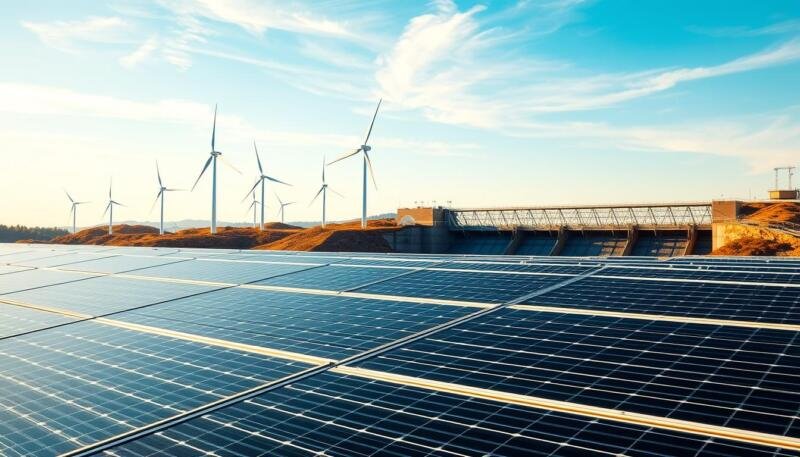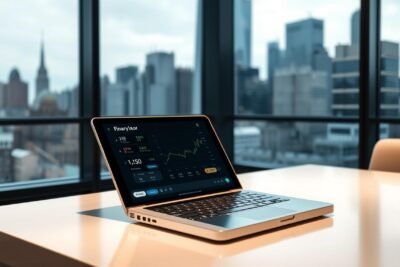
Canada Renewable Energy ETFs 2026: Top Picks for You

When you first hear about a big transition, it can feel distant. I remember a neighbour who watched a new wind farm rise outside town and wondered if there was a simple way to join the shift without picking single stocks.
That curiosity led them to research funds that track the clean energy theme. They wanted clarity on fees, holdings and how each fund fits a balanced portfolio.
This article puts those answers within reach. You’ll get a clear, investor-focused overview of how to compare an energy etf, read fee tables and match top picks to your goals.
We frame why momentum in the sector matters using real spending and industry signals, and then turn those big trends into practical screening steps. By the end, you’ll know what to check before you buy and how to size positions that suit your plan.
- Why Canada’s clean energy momentum matters for your ETF picks in 2026
- How to choose renewable energy ETFs for 2026: factors that really move returns
- Canada renewable energy ETFs 2026: our top picks roundup
- Fees, holdings, and risks compared: what your research should uncover before you buy
- Build your Canada-focused clean energy sleeve: allocation, diversification, and monitoring
- Your next step toward smarter green energy investing in 2026
Why Canada’s clean energy momentum matters for your ETF picks in 2026
Global moves toward lower-carbon power are reshaping which companies draw investor capital. You should care because that shift can change returns, volatility and the kinds of exposure you get from a clean energy etf.
Big-picture drivers matter: the IEA projects much higher use of renewable sources by mid-century, while BloombergNEF estimates trillions in capital for grids and supply. Major firms, including Shell, are boosting annual commitments to this transition. Those forces create long-term tailwinds for funds that hold profitable, cash-generative names alongside growth-oriented stocks.
Still, cycles will matter. Oil gas price swings, policy changes and interest-rate moves can rotate capital between traditional and new tech. Read recent reports and investment research to see how permitting, subsidies and domestic manufacturing incentives affect future cash flows.
- Check an ETF’s geographic and technology exposure (solar, wind, storage, EVs).
- Compare tilt toward mature companies versus early-stage developers.
- Mind liquidity and management approach when sizing positions.
| Driver | How it affects funds | Action for you |
|---|---|---|
| Policy & subsidies | Can boost cash flows and valuations | Track regional reports and timelines |
| Technology cost declines | Improves margins for solar, storage | Favor funds with balanced exposure |
| Oil gas price swings | Drives sentiment and rotation | Keep a mix of defensive and growth names |
How to choose renewable energy ETFs for 2026: factors that really move returns
Picking the right fund means focusing on a few concrete factors that drive returns. Start by screening for fees and management quality. ETFs usually have lower MERs than mutual funds and trade intraday, so cost and liquidity affect your net outcome.
Next, check index methodology and rebalancing rules. An index’s rules determine which companies appear, weightings, and turnover. Those rules explain why two funds with a similar theme can behave very differently.

Screen for fees, sector exposure, and index methodology
- Compare management fees and MERs; small differences compound over time.
- Map exposure across solar, wind, hydrogen and storage to gauge volatility.
- Review trading volumes and bid-ask spreads to assess liquidity before scaling positions.
Policy, rates, and technology cycles: what you should watch
Policy shifts and subsidy changes can quickly change valuations. Watch regional reports so you’re not over-exposed to one market.
Higher rates tend to compress multiples for long-duration growth companies. Stress-test holdings under different rate scenarios and check whether top names are profitable or cash-flow positive.
| Factor | Why it matters | Action for you |
|---|---|---|
| Fees & MERs | Lower ongoing costs improve long-term returns | Prioritize cost discipline when comparing candidates |
| Index rules | Drives inclusion, weight, and turnover | Read methodology documents and rebalance schedules |
| Sector exposure | Concentration affects volatility and upside | Align broad vs narrow coverage with your portfolio goals |
| Liquidity & trading | Affects execution costs and scaling ability | Check average daily volume and bid-ask spreads |
Use clear investment research and recent reports to confirm that holdings match the fund’s stated theme. If you want tools for execution and monitoring, compare platforms and order tools, or try a recommended broker list like the one here: best investing apps.
Canada renewable energy ETFs 2026: our top picks roundup
Compare a few representative funds to see how fees, domicile and holdings drive outcomes. Below are concise notes to help you match a product to your plan.

CIBC Clean Energy Index ETF (CCLN)
Low-cost, Canadian-listed access: Passive structure with a High risk rating. Management fee is 0.35% and MER 0.38%. That makes CCLN a clear candidate if you want a Canadian-listed clean energy etf for taxable or registered accounts.
ALPS Clean Energy ETF
This alps clean energy fund spans US and Canada companies across seven segments: solar, wind, energy storage, electric vehicles and more. Its holdings include Northland Power, Tesla, Plug Power, and ChargePoint, giving broad technology exposure.
Invesco Solar ETF
Choose this etf for concentrated solar upside. Top weights include Enphase, SolarEdge, Sunrun and First Solar. If you want solar-specific exposure to profit cycles, this is a targeted option.
Wind-focused funds
Funds that offer exposure to turbine makers and operators can capture global buildouts. Look for vestas wind systems, Ørsted and Nordex among top stocks when assessing these funds.
- Check holdings include real revenue exposure to clean technologies.
- Match domicile and liquidity to how you plan to trade.
- Use segment breakdowns to choose broad baskets or specialized plays.
Fees, holdings, and risks compared: what your research should uncover before you buy
You’ll want to confirm a fund’s costs, what it actually owns, and how it trades.
Start by checking management fees and MERs line by line. Small differences in basis points compound over years. ETFs often cost far less than mutual funds; some broad options run near 0.10%, while niche products can be higher. CCLN’s 0.35% fee and 0.38% MER offer a concrete reference point.
Holdings and real exposure
Inspect whether holdings include solar, wind, storage and hydrogen. Read the top 10 holdings, sector caps and country weights. That shows if the fund holds operational production companies or adjacent service names.
Volatility, liquidity and tracking
Evaluate daily volume, bid-ask spreads and tracking error. Thin trading raises execution costs and can widen real returns. Also watch turnover: index rebalances may trigger capital gains distributions.
| Item | What to check | Why it matters |
|---|---|---|
| Fees & MERs | Management fee, MER, expense ratio | Affects net returns over time |
| Holdings | Top 10, tech mix, company exposure | Determines volatility and upside |
| Liquidity & Tracking | Volume, spreads, tracking error | Impacts execution cost and performance |
| Risks | Policy, supply chains, market cycles | Can drive sharp moves in energy stocks |
Do the research: use fund documents and third-party reports to confirm methodology before you buy.
Build your Canada-focused clean energy sleeve: allocation, diversification, and monitoring
Think of a clean energy sleeve as part of your broader portfolio that needs clear rules and steady monitoring. A short plan helps you act calmly when the market moves.

Right-size your position: setting a 5-15% sector allocation within your portfolio
Set a target allocation of 5–15% based on your risk tolerance and time frame. Start near 5% if you are new and scale up as your conviction grows.
- Diversify across at least two etfs pair a broad fund with a focused satellite for balance.
- Revisit weightings quarterly and rebalance to limits to avoid concentration risk.
- Use limit orders and trade during high-liquidity windows to improve fills.
Compile a watchlist and review drivers: earnings, rates, and regulatory updates
Keep a compact watchlist of core companies that drive your funds. Use investment research and quarterly reports to follow margins, backlogs and pipelines.
Monitor macro drivers monthly: interest rates, inflation and oil gas moves often shift sentiment across the energy sector.
| What to monitor | How often | Why it matters |
|---|---|---|
| Top holdings & exposure | Quarterly | Shows concentration and real company risk |
| Earnings & project reports | Quarterly | Tracks cash flow and order pipelines |
| Macro & policy headlines | Monthly | Affects multiples for energy stocks and sector flows |
| Trading volumes & spreads | Ongoing | Impacts execution cost for etf trades |
Your next step toward smarter green energy investing in 2026
A small, practical checklist will help you move from research to confident buying.
First, shortlist two to three funds that match your thesis and skim each fact sheet to confirm production and revenue alignment. If you want solar energy upside, look for vehicles holding First Solar; for broad coverage, consider ALPS Clean Energy or similar funds.
Next, check holdings for wind systems names like Vestas Wind Systems and project-linked firms such as Bloom Energy. Read manager notes and compare methodology and costs.
When you’re ready, decide sizing and whether to phase entries. For extra reading on top thematic picks and market context, see a guide to top renewable stocks and ETFs and further thematic ETF research.
If you want to know other articles similar to Canada Renewable Energy ETFs 2026: Top Picks for You you can visit the category Investing.






Leave a Reply